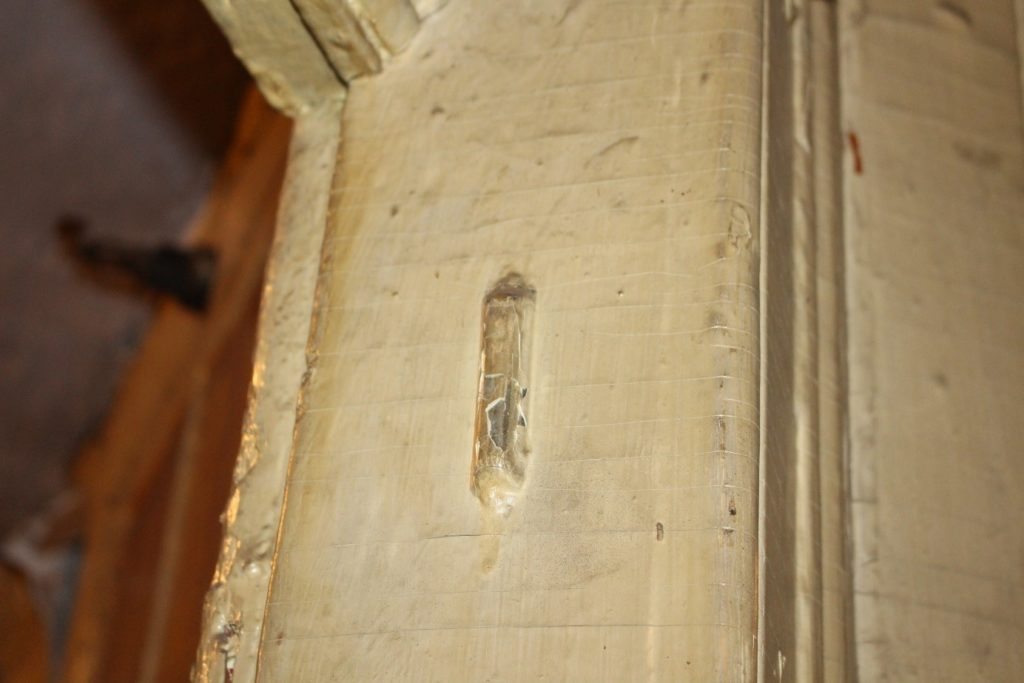Behind The Scenes, Object Spotlight
97 Orchard Street Mezuzah
June 25, 2019

The item depicted in this photograph of a bedroom doorway to an unrested apartment on the third floor at 97 Orchard Street is not a doorbell; it is a mezuzah. Between 1863 when it was built, and 1935, when it was condemned as a residence, 97 Orchard Street is estimated to have been home to approximately 7,000 residents. Between 1890 and 1920, the vast majority of these residents were Ashkenazi Jewish immigrants from Eastern Europe and their American-born children. As observant Jews, these residents often affixed mezuzahs to the doorways of their apartments as well as its interior rooms to signify the boundary between the outside world and the home.
Found throughout 97 Orchard Street on most of the building’s doorways, mezuzot consist of a decorative case containing a piece of parchment, upon which is written Hebrew Verses from the Torah, Deuteronomy 6:4-9 and 11:13-21. According to Jewish law, mezuzot are to placed on the right side of a doorway, and most Ashkenazi Jews do so with the top slanted inwards towards interior of a room and the bottom towards the outside world.
As you can see in this photo, the particular mezuzah that was installed in the bedroom doorway of apartment #9 at 97 Orchard Street was installed vertically, without the prescribed slant mentioned above. Jewish law does indicate that, when a doorway is too narrow to allow for a slant, the mezuzah may me affixed vertically. Yet, this particular doorway was clearly wide enough to accommodate a slant. This might suggest that the resident who installed it was a non-Ashkenazi Jew, perhaps Sephardim – in whose tradition many place mezuzot vertically. There may, however, be additional factors that help explain this interesting orientation
It is customary to remove the mezuzoh from one’s home when vacating the apartment or building, though the owner may leave it in place if it is known the next tenant or owner will also be an observant Jew. It may be that the original owner of this mezuzah believed the tenant following them in this apartment would also be Jewish. It is also considered disrespectful to paint over already installed mezuzot. Some interesting reasons why this might be are explored in this month’s feature article, When A Door is Not (Just) A Door. But, to borrow a quote from the below, it is helpful when thinking through these questions to remind ourselves that: “everyone forms their own relationship with god, and the home becomes the physical manifestation of their interpretation.”
The mezuzohs at 97 Orchard Street, including the one pictured here, remained affixed to doorways of apartments that Museum researchers know to have been inhabited by non-Jewish residents. In the case of the pictured mezuzah, the last residents of this apartment were the Sicilian-Catholic Baldizzi family. Why did the Baldizzi family choose not to remove this mezuzah? Was it superstition? Or respect for another religion or culture?
Oral history interviews conducted in the late 1980s and early 1990s with Josephine Baldizzi Esposito, who lived with her family in this apartment between 1931 and 1935, when she was between five and nine years of age, suggests it may be the latter. Indeed, the Baldizzis formed a close relationship with their Jewish neighbors down the hall, the Rosenthals, who Josephine helped observe their religious traditions:
“In the back room, there was a shaft, a window facing a shaft and then there was, across the way, was another window. And back there was the….the Rosenthals lived there. I can still see Mrs. Rosenthal in the air shaft window, waving to me, motioning for me to come in and to turn on the lights because it was the Sabbath, the Jewish holiday, and they weren’t allowed to touch the electricity. And it made me very proud to have to do that. I used to feel good that she chose me to do that job for her. And I can still see her till today, the vision of her in that window. It has never left my memory.”